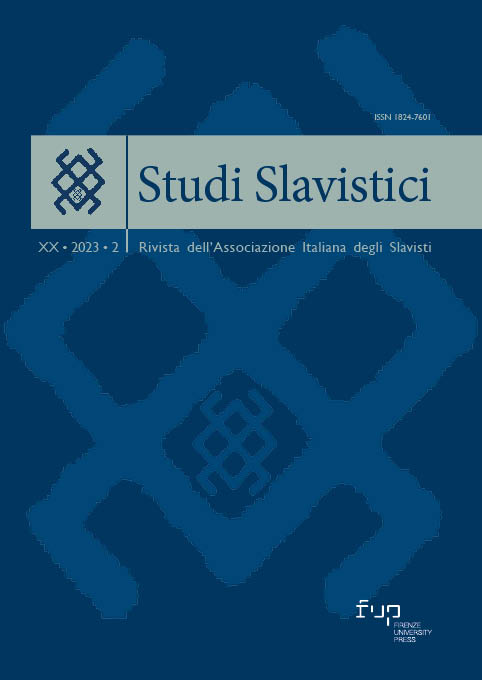Published 2024-01-29
Copyright (c) 2024 Monica Perotto

This work is licensed under a Creative Commons Attribution 4.0 International License.
Abstract
In Italy the teaching of translation as a specific skill for bilingual speakers is normally not included in the programs of Russian special schools, the so-called subbotnie školy, where the development of language skills (especially listening, writing and grammar accuracy) in heritage speakers generally takes top priority. As already pointed out in other works (Perotto 2020, 2022), the activity of translation exerts an important influence on the cognitive development of the child, especially if bilingual. It helps him/her not only to differentiate and develop two parallel linguistic and cultural systems, but to approach them with a greater metalinguistic and cultural awareness. On the basis of translations made by bilingual participants to the international Cultural Bridge competition, Russian-Italian an Russian-English parallel corpora were created for the analysis of translation difficulties of heritage speakers living in Italy and USA. These difficulties will be analyzed separately or comparatively on the Sketch engine platform, providing some basic indications for a more targeted teaching of translation. The use of corpora can be an important teaching tool to improve heritage speakers’ linguistic competence and translation awareness.
References
- Chamraeva 2015: E.A. Chamraeva, Russkij jazyk dlja detej bilingvov: teorija i praktika, Moskva 2015.
- Daloiso 2022: M. Daloiso, L’educazione bilingue in età prescolare. Una ricerca sulla scuola ladina di Fassa, Trento 2022.
- Fabbro 2004: F. Fabbro, Neuropedagogia delle lingue. Come insegnare le lingue ai bambini, Roma 2004.
- Goletiani 2015: L. Goletiani, Natural Translation Features in Early Bilingualism, in: V. Warditz, B. Kreß (eds.), Multilingualism and Translation, Lausanne 2015 (= Potsdam Linguistic Investigation, 17), pp. 37-55.
- Grosjean 2010: F. Grosjean, Bilingual. Life and Reality, Harvard 2010.
- Harris 1977: B. Harris, The Importance of Natural Translation, “Working Papers on Bilingualism”, 1977, 12, pp. 96-114.
- Harris, Sherwood 1978: B. Harris, B. Sherwood, Translating as an Innate Skill, in: D. Gerver, H.W. Sinaiko (eds.), Language Interpretation and Communication, New York 1978, pp. 155-170.
- Malakoff, Hakuta 1991: M. Malakoff, K. Hakuta, Translation Skill and Metalinguistic Awareness in Bilinguals, in: E. Bialystok (ed.), Language Processing in Bilingual Children, Cambridge 1991, pp. 141-166.
- Warditz, Kreß 2015: V. Warditz, B. Kreß, (eds.) Multilingualism and Translation, Lausanne 2015 (= Potsdam Linguistic Investigation, 17).
- Naiditch 2015: L. Naiditch, Language Proficiency, Bilingualism and Translation Studies, in: V. Warditz, B. Kreß, (eds.) Multilingualism and Translation, Lausanne 2015 (= Potsdam Linguistic Investigation, 17), pp. 131-140.
- Ovčinnikova, Pavlova 2016: I.G. Ovčinnikova, A.V. Pavlova, Psicholingvističeskaja interpretacija ošibok pis’mennogo perevoda kak otraženie osobennostej perevodčeskogo bilingvalizma, in: S.N. Cejtlin (red.), Liki bilingvizma, Sankt-Peterburg 2016, pp. 153-202.
- Paradis 2004: M. Paradis, A Neurolinguistic theory of Bilingualism, Amsterdam-Philadelphia 2004.
- Perotto 2015: M. Perotto, Evidence of Attrition in Second-Generation Russian-Speaking Immigrants in Italy, “Russian Journal of Communication”, vii, 2015, 2, pp. 242-247.
- Perotto 2016: M. Perotto, Realtà sociolinguistiche a confronto: Alto Adige e Tatarstan. Aspetti di politica linguistica e pianificazione educativa, in: A. Alberti, M.C. Ferro, F. Romoli (a cura di), Mosty Mostite. Studi in onore di Marcello Garzaniti, Firenze 2016, pp. 229-239.
- Perotto 2019: M. Perotto, Acquisizione e apprendimento linguistico degli heritage speakers russofoni della scuola N. Gogol’ di Roma: ultimi sviluppi dell’indagine, in: I. Krapova, S. Nistratova, L. Ruvoletto (a cura di), Studi di Linguistica slava. Nuove prospettive e metodologie di ricerca, Venezia 2019, pp. 425-438.
- Perotto 2020: M. Perotto, Konkurs Kul’turnyj most i problemy perevoda u detej bilingvov, in: Gorizonty sovremennoj rusistiki. Sbornik Meždunarodnoj naučnoj konferencii, posvjaščennoj 90-letnemu jubileju Akademika V.G. Kostomarova, Moskva 2020, pp. 1055-1063.
- Perotto 2022: M. Perotto, Korpusnyj podchod k analizu perevodov učastnikov konkursa Kul’turnyj most: prodolženie issledovanija, in: M.A. Elivanova, I.A. Krylova, S.V. Krasnoščekova (red.), Problemy ontolingvistiki – 2022: rečevoj mir rebenka, Sankt Peterburg 2022, pp. 151-159.
- Polinsky 2018: M. Polinsky, Heritage Languages and Their Speakers, Cambridge 2018.
- Protassova et al. 2015: E. Protassova, J. Ekman, S. Kirichenko, Development of Translation Skills in Russian-Finnish Bilinguals, in: V. Warditz, B. Kreß, (eds.) Multilingualism and Translation, Lausanne 2015 (= Potsdam Linguistic Investigation, 17), pp. 141-165.
- Sadoja 2015: K. Sadoja, Translation Strategies of Bilingual Children: A Case Study, in: V. Warditz, B. Kreß, (eds.) Multilingualism and Translation, Lausanne 2015 (= Potsdam Linguistic Investigation, 17), pp. 167-186.
- Salmon 2017: L. Salmon, Teoria della traduzione, Milano 2017.
- Salmon, Mariani 2008: L. Salmon, M. Mariani, Bilinguismo e traduzione. Dalla neurolinguistica alla didattica delle lingue, Milano 2008.
- Vygotskij 1990: L.S. Vygotskij, Pensiero e Linguaggio, Bari 1990.
- Zalevskaja 2011: A.A. Zalevskaja, Nekotorye spornye teorii dvujazyčija, in: Put’ v jazyk: odnojazyčie i dvujazyčie, Moskva 2011, pp. 33-47.


